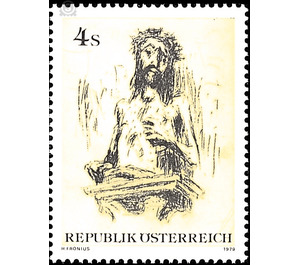Modern Art - Austria / II. Republic of Austria 1979 - 4 Shilling
Theme: Art & Culture
| Country | Austria / II. Republic of Austria |
| Issue Date | 1979 |
| Face Value | 4.00 |
| Color | green |
| Printing Type | offset |
| Stamp Type | Commemorative |
| Item Type | Stamp |
| Chronological Issue Number | 969 |
| Chronological Chapter | OOS-OE2 |
| SID | 631042 |
| In 69 Wishlists | |
Hans Fronius was born on 12 September 1903, the son of a doctor in Sarajevo. The artistic component of his personality is the legacy of his mother, who came from the Viennese artist family Passini. Until the end of the First World War he lived with his family in Graz, after which he attended from 1922 the Academy of Fine Arts in Vienna. However, he soon sought new ways and gained experience in the course of longer trips to Europe. In 1930 he began working as a professor of art education in Graz, later in Fürstenfeld. After the Second World War, he continued his professional and now very successful artistic work. He received worldwide recognition as a draftsman and illustrator of works of world literature. In 1952, he exhibited at the Albertina his up to this time originated work. In 1958 he was representative of Austria at the Venice Biennale. Exhibitions in Mexico City, Hamburg, Bremen, Stockholm and Stuttgart will follow in the following decade. Also in the seventies, many successful presentations of his works at home and abroad follow. The brand image shows the suffering, thorn-crowned Christ.


